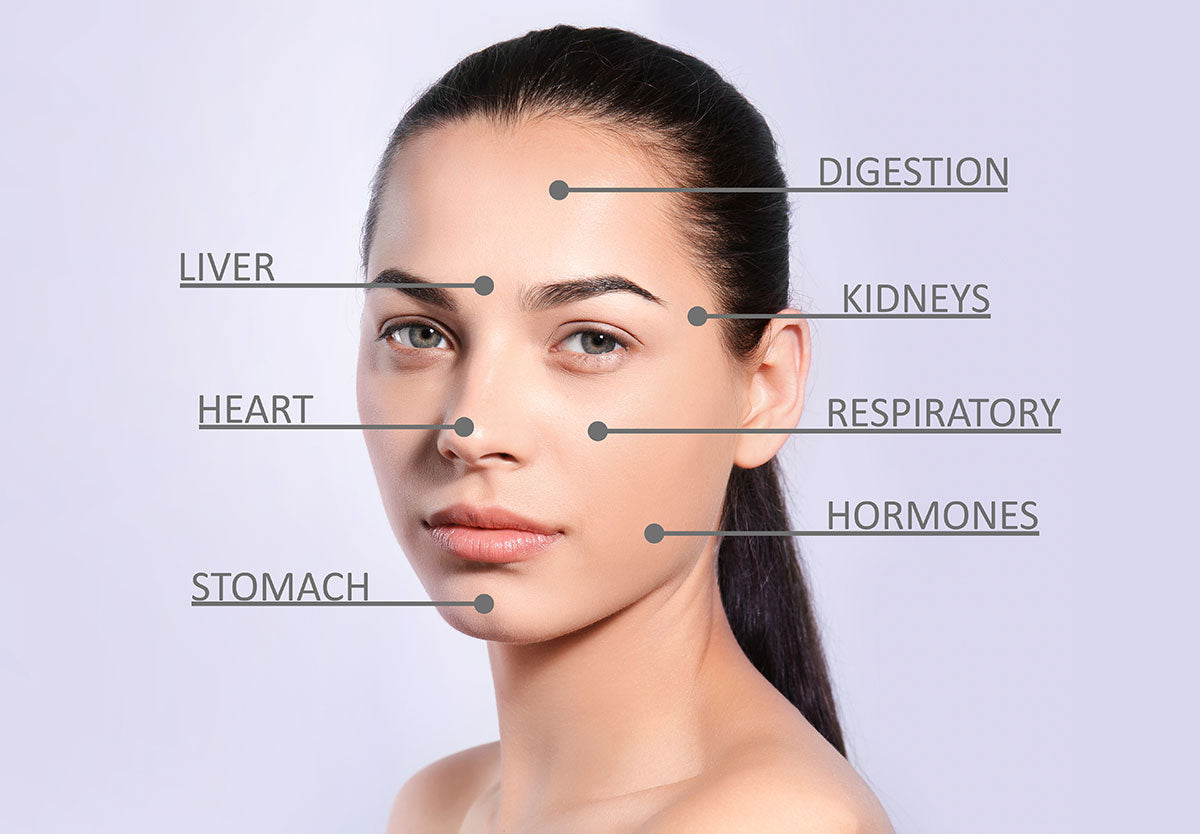With the saying “everything old is new again,” what springs to mind is an ancient technique known as face mapping, especially when it comes to understanding your skin and any potential breakouts. For example, that annoying pimple in the middle of your forehead, how can face mapping reveal why this is happening?
The theory of face mapping connects that specific area of your face to an organ or body part, and that association allows you to make changes to your diet or lifestyle that may help heal your acne flare-ups from the inside out. The questions remain though, where does face mapping come from and how can you use it to diagnose the causes of different facial breakouts? Let’s take a look.
Face mapping defined
Face mapping is an ancient practice rooted in Ayurveda teachings and Chinese medicine that treats your face as a road map to pinpoint underlying issues in other parts of your body. The technique goes back thousands of years, and a lot of it comes simply from clinical experience. Nowadays, you have all types of blood tests and scans, but back then, doctors would have to give a diagnosis by looking, touching, and asking questions.
Chinese medicine states that all organs have a different color, temperature, and taste, and are manifested in a certain way. According to traditional Chinese medicine, the liver, for example, is manifested in the eyes. In fact, one of the first symptoms of jaundice--a liver disease--includes yellowing of the eyes, which was true 2000 years ago, and it’s still true today.
In essence, location-based breakouts are a common issue, specifically certain trends that may create patterns of acne breakout on areas of the face such as female hormonal acne that is presented as lower face and neck pimples. However, if you can use face mapping to combine this treatment style with approaches that are more focused on the breakouts themselves. You should treat your face with an individualized approach, unique from everyone else, because the same cause can present as different distributions of acne on different people.
Some people break out on their cheeks with stress, others on their forehead or even their back. Again, the type of acne is more important than the area.
The ins and outs of face mapping
The quality of the skin on your face provides an expression of your health. It’s important to know that the body is made up of a network of systems—lymphatic, neurological, digestive, to name a few—and all of these systems are tied together. It’s very difficult to affect one without affecting others, as everything is connected.
Face mapping is a way to verify what’s going on inside your body, since all parts of your body (including organs) are interlinked. In Chinese medicine, the professionals look at the body as a whole and how everything works together, however there is no direct evidence that breakouts on the skin correspond to imbalances of internal organs. That being said, there are certain patterns of facial breakouts that can offer clues to what’s triggering problematic skin.
Reading your skin
What are the following locations on your face saying about your overall health and how you can reduce flare-ups in your usual breakout hotspots.
Above the brows
The area above your brows is linked to your gallbladder and liver. If you’re getting breakouts there, try eating less processed or junk food and reduce the amount of fat in your diet.
For forehead breakouts, switch to oil-free hair care products. Also, most people tend to wash their face first, then apply hair products afterward. These products can drip down onto the forehead and clog pores. Instead, apply hair products first, then wash your face to prevent buildup on the forehead from the scalp.
Between the brows
Breakouts between your brows might mean that you’re drinking or smoking too much, or eating too many rich foods. Cut down on rich foods, butter, cheese, and late-night snacks, and incorporate more exercise into your routine, while also getting more sleep.
The nose
Your nose, in the face mapping principle, is connected to your lungs and heart. To combat breakouts in this area, cut back on spicy foods, meat, and salt and replace them with fruits, veggies, and nuts--which are full of healthy fats like omega-3 and omega-6). If you’re getting constant breakouts on your nose, you may want to check your blood pressure and vitamin B levels. Upping your vitamin B intake can help combat flare-ups.
Left cheek
Since Chinese medicine emphasizes the left and right, if you’re breaking out on the left side of your face, it’s recommended to eat “cooling foods” such as winter melon, cucumber, and the like. The left cheek is more connected to your liver, which operates at its weakest between 1 p.m. and 5 p.m. in the afternoon. If you’re having a breakout on your left cheek, try to avoid any strenuous work during that time of day.
There could be another common cause for persistent cheek skin problems, and some you might not even consider. If you’re experiencing cheek breakouts, make sure to wipe down your phone screen multiple times per day and/or to opt for headphones to prevent buildup of oil and bacteria on the face. Also, over-the-counter cleansers with 2% salicylic acid can penetrate deep into oil glands and unclog pore, making them helpful for preventing buildup on your skin.
Right cheek
The right-side cheek has a connection to your lungs. It’s suggested to do aerobic and breathing exercises early in the morning to strengthen your lungs and to improve the acne situation on your right cheek. Also, the right cheek responds more strongly to sugar than other parts of the face, therefore if you’re breaking out on your right cheek, consider cutting back on junk food and sugar, as well as wine and seafood.
The mouth area
If you suffer from breakouts around your mouth, your diet could be partially responsible. This area around your mouth is associated with your digestive organs, as in your intestines and liver. Cut back on spicy foods and fried food while eating more fiber, fruits, and veggies.
Your chin
If you break out around your chin, you should get your hormone levels checked, as stress can also be a large part of skin complications. Breakouts on the lower third of the face (cheeks, chin, and jawline) point to hormonal acne, which tends to flare up around the menstrual cycle, and can occur with or without underlying hormonal abnormalities such as polycystic ovarian syndrome (PCOS). To ease these breakouts, try drinking spearmint tea and taking omega-3s, as well as talking to your doctor about your hormone levels.
The takeaway
Even in today's modern world, the ancient Chinese practice of face mapping is still relevant. Along with Western medical science, the connection between organ health and skin health that is the foundation of face mapping can provide useful information for anyone struggling with problematic breakouts—providing another piece of the puzzle when creating a holistic and wellness treatment plan for healing your skin.





